Table of Contents
General Information
Many people write and ask me about spider bites. As I’m not a doctor I can’t diagnose or offer treatment for these bites. You MUST see a doctor if you are concerned about a bite you receive. Many other animals also produce symptoms similar to some spider’s bites. Some of these are – kissing bugs, fleas, bed bugs, flies, mites, wasps, ants and blister beetles all of which have produced lesions similar to a brown recluse spider bite. Many skin disorders and medical conditions can produce lesions that can also mimic a brown recluse spider bite. Some of these include infected herpes outbreaks, bedsores, diabetic ulcers, poison oak and Lyme disease which can be caused by a tick bite. Again, use common sense: If there is a wound that is not healing as expected or getting worse, see your doctor!! If a spider is not listed here, like the orb weaving family of spiders, it is because their bite is not significant being no worse than a bee or wasp sting. However, any person can be allergic to spider bites so a doctor should be consulted if any symptoms of an allergic reaction are present. Any emails published are done so at reader’s requests and no responsibility is take for validity or proof of results.
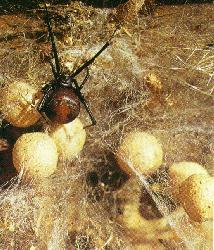
Here’s another reader’s email on treatment for a neurotoxic bite she received:
Hi, I got bitten a few years back. I was bitten on the neck. I t made a small pimple with a little bit of redness, but with that came dizziness, heart palpitations, shivers and difficulty breathing. I couldn’t lift my head off the pillow. I went to the doctor who said bed rest and antibiotics. Two weeks later I had half my lung capacity , dizziness, brain fog and no energy. I spent the whole time on the internet trying to get information. After about four weeks with little improvement and not being able to find anything on neurotoxic spider bites as far as a detox was concerned, I looked up neurotoxic detox and found a heavy metal poison detox. I thought that neurotoxins probably behave in the same way so I it and in 24 hours I had my lung capacity back. After a few days I was feeling almost back to normal. I still have to detox from time to time.I start getting slight symptoms again and I get bumps on my neck around the same area. The nature of neurotoxic poisons is that they cycle around your body because your small intestine keeps sucking them back up. You need something that will bind to the neurotoxins in the small intestine so that they can exit the body. There are a few detoxes available on the internet. I used the one involving cilantro tincture, chlorella and zeolile in a specific order. I used this article found on the internet. Its a bit complicated but I got the gist.
I hope this helps, Fiona (South Africa)
A reader sent in this advice which I have been unable to confirm but it is worth mentioning
“Some people who have a penicillin allergy can have a bad reaction to a spider bite that normally would not have an effect on people. The spider’s web is made up of the same compound as penicillin and so penicillin is found through out a spider’s body.”
Here’s some more info from a reader regarding tick bites and spider bites:
“You posted a pic of a woman that was diagnosed as having a spider bite but was later identified as a tick bite. Three years ago, I had the exact same reaction to a tick bite. I had been hiking in Northern Virginia along the Potomac. Although I told doctors that I had been bitten by a tick at the exact location of the small cluster of white pustules, the doctors at both urgent care and then Arlington Hospital told me it could not be a reaction from the tick because I had no other symptoms. After being treated for STAPH and then MERSA, with no success, I was lucky to find a specialist who identified the unusual rash as asymptomatic Lyme disease. More doctors, as well as hikers, need to be aware that not all reactions to spider and tick bites are identical.”
Here’s the symptoms of bites from some of the dangerous and not so dangerous spiders you may encounter.
Black/Brown Widow/Redback:
Black Widow spiders live in the USA and are from the Theridiiae family of spiders. In other parts of the world, members of the same family with much the same symptoms are – Redback spiders (Australia), Katipo (New Zealand), the Button Spider (Sth Africa) and in Europe as Malmignatte or Karakurt. They all belong to the genus Latrodectus, a subset of the family Theridiidae. They often live in dark places under garden objects like pots and chairs so quite often come in contact with humans when gardening.
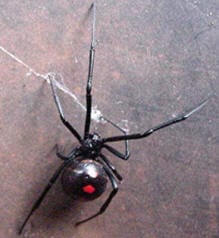
Symptoms:
- A black widow spider bite might not be felt at all or if felt, may feel like a pin prick.
- At first, there might be only slight local swelling. Then you may notice two faint red spots surrounded by local redness at the bite.
- The pain usually progresses up or down the bitten arm or leg, finally localizing in the abdomen and back. There might be pain in the muscles and soles of the feet, and eyelids can become swollen.
- Widow spiders bites are neurotoxic which means that they inject a toxin that affects the nervous system. This causes muscle and chest pain or tightness and these are some of the most common reactions to the widow toxin.
- Other symptoms may be tremors, laboured breathing and speech, nausea, profuse perspiration, and vomiting.
- In more serious cases, the victim may have cold clammy skin, a weak pulse; they may lapse into unconsciousness and convulsions may occur.
- Although extremely painful and temporarily debilitating, fatalities from untreated widow bites are uncommon. Only the bite of the female, usually the adult female, is potentially dangerous.
Treatment:
- Remain calm and seek medical attention as soon as possible. There is an antivenin available for widow bites and usually only the very young, elderly or those with high blood pressure are at greatest risk
- Clean the site well with soap and water. You can apply a mild antiseptic to prevent infection at the site of the bite. Apply a cold pack but don’t let it freeze the affected area.
- Elevate the limb to heart level and keep the patient quiet and warm.
- Doctors can inject calcium gluconate to counteract most effects of the toxin.
- DON’T use the pressure immobilisation method that is used with other bites as this does nothing and increases the pain!
NOTE: Other spiders in this family of Steatoda such as the brown house spider do have medically significant bites described as being like a very minor widow spider bite. Widow antivenin can be used to treat these bites if necessary.
Brown Recluse Spider:
]The brown recluse spider (Loxosceles reclusa) is also known as the violin spider or fiddleback spider because of its violin-shaped marking on the cephalothorax. It is about a half-inch long (including legs) and is a solid light brown colour. The violin marking is configured with the base of the violin beginning at the eyes and the neck of the violin pointing toward the “waist.” Often, the violin marking is difficult to see clearly so two other features can help identify the brown recluse – it has six eyes rather than the usual eight and the abdomen has no markings. Recluse spiders got their name from their habit of hiding away in dark places where it is not easily disturbed. A bite from a recluse spider may require no more than the general spider bite treatment.
There may be some localized swelling and redness, but healing can occur without much intervention. However, in some cases the symptoms and skin and health problems can become quite serious. Necrotic arachnidism is a term given specifically to the bite of a brown recluse spider. This refers to the ulcerative type lesion that sometimes accompanies the bite. The venom of a brown recluse is primarily comprised of proteins and enzymes that actually cause some platelet disruption and tissue damage. Rarely do these bites cause death. However there have been reports in young children and the elderly. If there are going to be systemic effects, which are generalized effects, they will usually occur within the first 3 days of the bite.
Symptoms:
- The brown recluse spider bite usually causes some pain or burning in the first 10 minutes, accompanied by itching.
- The wound takes on a bull’s-eye appearance, with a centre blister surrounded by an angry-looking red ring and then a blanched (white) ring.
- The blister breaks open, leaving an ulcer that scabs over.
- The ulcer can enlarge and involve underlying skin and muscle tissue. Pain may be severe. A generalized red, itchy rash usually appears in the first 24-48 hours.
- Other symptoms include fever, chills, nausea, vomiting, muscle aches and hemolytic anemia (a condition where the red blood cells are destroyed).
- People bitten by an unseen spider sometimes blame the brown recluse spider because their bite resembles a brown recluse spider bite. However, there are a number of other spiders and insects, as well as other medical conditions, that are capable of producing tissue wounds of similar appearance, but these are usually of a lesser severity.
Treatment:
- Wash the wound and apply an antibiotic ointment.
- The victim should seek medical attention if there are signs of an infection, an ulcer that does not heal, a bite accompanied by nausea, vomiting, fever or a rash.
- There is no special treatment or medication used to treat a brown recluse spider bite.
- If infection develops, antibiotics are used. If a wound becomes deep and infected, occasionally surgery is needed.
- There is an antivenin available for brown recluse bites. However, the recluse antivenin is most effective if given early, and because of the relatively painless bite delivered by recluses, patients do not often present until 24 or more hours after the event, possibly limiting the effect of this intervention. Use of antivenin is generally not indicated unless serious symptoms are present, and/or the patient fails to respond to other forms of treatment
- Anytime there is a bite or a wound that is not healing and getting worse, see your doctor.
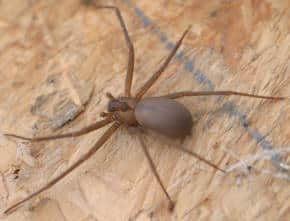
Brazilian Wandering Spider:
The Brazilian Wandering spider (Phoneutria genus), is a large, brown spider rather like a North American Wolf spider in appearance. However, it has a highly toxic venom (one of the most neurologically active), and is regarded as among the most dangerous spiders in the world. It, like several other more harmless spiders, may hitch a ride in clusters of bananas and has been found in the United States. As a result, any large spider appearing in a bunch of bananas should be treated with due care.
Many of the bites of this species are alleged to be dry bites. The bite can be one of the most excruciating of all spider bites because of the large size of the chelicerae (fangs) and considering the high levels of serotonin contained in the venom.
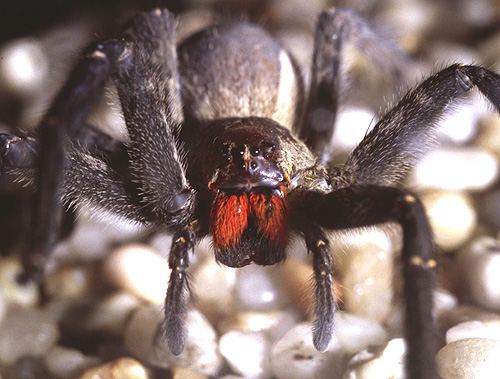
The spiders are as large as some small tarantulas and have fairly long fangs. While venom from this spider can be deadly to children and the infirm, since the development of an antivenin in 1996, no human deaths from their bites have been recorded.
Symptoms:
- Extremely painful bite and immediate pain.
- Heavy perspiration and drooling
Treatment:
- Seek medical attention immediately.
- Keep the patient calm and quiet to avoid spreading the venom.
- An antivenin is available for the bite.
Camel Spiders:
Camel spiders belong to the order Solifugae, also known as wind scorpions or sun spiders. They are neither spiders nor scorpions. In the Middle Eastt, it is common belief among some American soldiers stationed there that Solifugae will feed on living human flesh. The story goes that the creature will inject some anesthetizing venom into the exposed skin of its sleeping victim, then feed voraciously, leaving the victim to awaken with a gaping wound. Solifugae, however, do not produce such an anesthetic, and do not attack prey larger than themselves unless threatened.

Symptoms:
- Camel spiders do not produce venom but have large jaws so their bite can produce a significant wound.
Treatment:
- Treatment with antibiotics is often necessary as the wound may become infected.
- Seek medical attention if symptoms. persist.
Hobo Spider:
The Hobo spider, Eratigena agrestis, is a moderately large spider of the family Agelenidae which is indigenous to western Europe and was introduced into the north western United States sometime before the 1930’s. In its native Europe the hobo spider is a resident of fields, rarely entering human habitations due to the presence of major competitors, particularly the giant house spider, Eratigena atrica, which is a common resident of houses and other man-made structures in Europe; thus, human contacts with the hobo spider are uncommon in Europe. The reason hobo spiders have a reputation for being so aggressive is because they have very poor eye sight and have to aggressively attack their prey to catch it. Hobo spider’s bites are quite often thought to be brown recluse bites because of the similarity of symptoms.
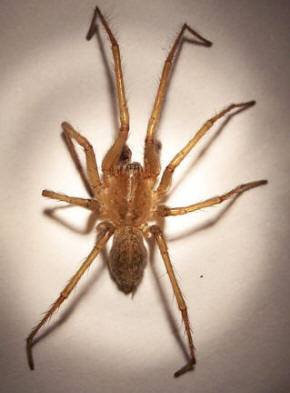
Symptoms:
- The hobo spider’s bite initially produces a slight prickling sensation.
- Within 30 minutes a small, insensitive hard area appears , surrounded by an expanding reddened area of two to six inches in diameter.
- The area blisters between 15 and 35 hours after the bite,.
- About 24 hours later, the blisters break and the wound oozes. It scabs over, but tissues beneath the scab continue to die and sometimes surgical repair is needed.
- The most common symptom in addition to the bite is a migraine headache.
- The fully developed lesion can vary from one-half to one-inch or more in diameter and may take several months to heal.
- In many cases, the bites do not progress to this stage.
Treatment:
- In most cases all that is necessary is to clean the local wound.
- Apply topical antibiotics and give a tetanus shot.
- Skin grafting is rarely necessary.
- Anytime there is a bite or a wound that is not healing and getting worse, see your doctor.
Garden Orb Weavers:
The garden orb weaver spider is a very common species of spider with many variants in size, shape, and colour in many countries like Australia and the USA. The prefer warmer climates. They have very large abdomens when well-fed and exhibit a tremendous colour-range from off-white through tan, brown to almost black. They have a roughly leaf-shaped pattern on the top of their abdomen with a complex outline that is darker than the surrounding area. There may also be several whitish spots or one or more stripes. The spiders’ cephalothoraxes (heads) and proximal (closer to the body) leg segments are usually darker, mostly reddish or reddish brown. They are able to change their colour with each moult to better match the background upon which they rest during the day.
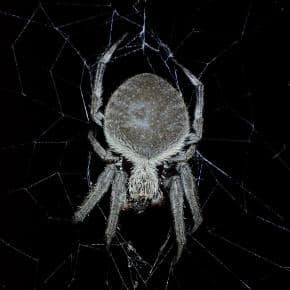
The spiders are notable for the often large and intricate webs which they weave at night. They are usually nocturnal feeders, resting head down in their webs waiting to catch flying insects. They make their sticky rounded orb webs near lights and between trees where insects are likely to fly. During the day the spider will often rest somewhere near the web, usually under a leaf or twig, or in a crevice in bark or rock. They are commonly found around human habitation so may be found resting under eaves and in similar places. When disturbed they will retreat towards this rest area, although under imminent danger the spider will drop to the ground and “play dead”. Occasionally individual spiders will remain on the web during the day, possibly when prey has not been caught for a while, but this makes them more vulnerable to predation by birds.
Symptoms:
- Their bite is not dangerous to humans but may induce mild, local pain, redness, and occasionally swelling for a period of 30 minutes up to three to four hours.
Treatment:
- Clean the site well with soap and water. You can apply a mild antiseptic to prevent infection at the site of the bite. Apply a cold pack but don’t let it freeze the affected area.
Huntsman Spiders:
Huntsman spiders being so large, often scare people. They are large, defend their nests, and may move toward people and make threat displays. They frequently enter houses and hunt over the walls and ceilings where they may run rapidly for long distances without pausing. When they actually do bite people, the bites are very unpleasant, but these spiders are not regarded as dangerous. They are quite common in parts of Australia and the United States. Australian huntsman spiders are typically non-aggressive except when defending their nests or their young. There is one spider in California and Japan, probably a huntsman (tentatively identified as a member of the Sparassidae family, Heteropoda venatoria), which might run over and bite your finger if you touch the wall that it is clambering over.
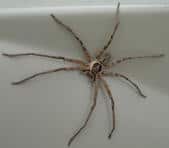
That behavior may well occur because its eyesight is good enough to see movement and general shape, but not sufficient to avoid mistaking something else for its natural prey. In general, however, members of this genus scramble wildly to escape when they become aware of a human moving into their vicinity.
Symptoms:
- Huntsman spider bites usually result only in transient local pain and swelling.
- However, some Badge Huntsman spider bites have caused prolonged pain, inflammation, headache, vomiting and irregular pulse rate.
Treatment:
- A cold pack may relieve local pain.
- Seek medical attention if symptoms persist.
Jumping Spider:
Jumping spiders (Salticidae) are the personalities of the spider world. Though generally small in size (up to 12 mm body length), their large eyes, prodigious jumping ability, often brilliant colours and cocky, inquisitive activity make them very appealing. Many are daylight hunters, using their excellent vision to track, stalk and calculate distance, before suddenly leaping on their prey, propelled by their strong back legs. Males are often more strikingly coloured, patterned or adorned with leg or body hair tufts than are females. The jumping spider is the most common biting spider in the United States. Bites are most often no worse than a wasp bite but in some cases can have more serious symptoms.
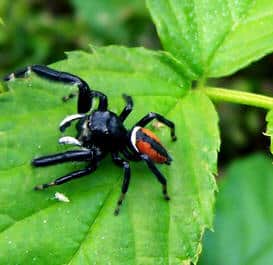
Symptoms:
- The bite can be painful and itchy.
- The site may become red, and there may be significant swelling.
- Symptoms that are more serious include painful muscles and joints, headaches, fever, chills, nausea and vomiting which may last from 1 to 4 days.
Treatment
Wash the wound and apply an antibiotic ointment.
The victim should seek medical attention if there are signs of an infection, nausea, vomiting, fever or a rash. If infection develops, antibiotics are used.
- Anytime there is a bite or a wound that is not healing and getting worse, see your doctor.
Tarantulas:
Tarantulas are large myglamorphs and are often kept as pets because of their docile nature. They belong to the family Theraphosidae, of which approximately 900 species have been identified. Tarantulas hunt prey on the ground and do not spin webs unless they live in a tunnel. They line their tunnel with web to catch wandering prey. They mainly eat insects and other arthropods, caught by speed or ambush. The biggest tarantulas can kill animals as large as lizards, mice, or birds. Most tarantulas are harmless to humans, and some species are popular in the exotic pet trade while others are eaten as food. These spiders are found in tropical and desert regions around the world. The primary means of defense for these spiders are urticating hairs on their abdomen, which can cause irritation and other typical symptoms in humans.
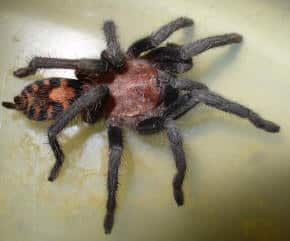
Many tarantula species will frequently kick hairs off their abdomens, directing them toward potential attackers. These hairs can embed themselves in the other animal’s skin or eyes, causing physical irritation.
Symptoms:
- Tarantulas rarely bite. If they do, the bite generally does not produce significant poisoning symptoms. The bite will look and feel a lot like a bee sting.
- Some swelling will occur and there may be quite a bit of pain, simply because of the size of the spider.
Treatment:
- Remove dirt from the wound by washing the bite with soap and water to prevent infection.
- A cold pack may relieve local pain.
- Seek medical attention if symptoms. persist.
- Most people will not have an allergic reaction to a tarantula bite. If you do, take an antihistamine immediately and call 9-1-1.
Wolf Spider:
Wolf spiders are very common in the garden and sometimes wander into people’s houses. They are large, hairy spiders, up to 3-4 inches across. They are a mottled gray-brown colour often with brown stripes, which helps them hide in sand, gravel, leaves and other debris. Female wolf spiders carry their young on their backs. Except for one group, wolf spiders do not spin webs. They tend to burrow into the earth and hide. They are aggressive, come after their prey and are fast runners. Because of their impressive size and aggressiveness, wolf spiders can easily incite panic. Most bites from wolf spiders produce little or no symptoms but their bites have been reported as necrotising in some cases.
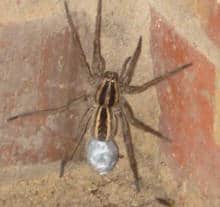
Symptoms:
- Wolf spider’s bite can cause pain, redness and swelling.
- The large jaws/fangs can cause a tear in the skin as they bite.
- Swollen lymph glands may develop.
- The skin area at the bite may turn black.
- Swelling and pain can last up to ten days.
- Some bites have been associated with the same sort of necrotic lesions as brown recluse and hobo spiders but these are very rare.
Treatment:
- If the arm or leg is bitten, it should be elevated to help prevent swelling.
- Wash the wound with soap and water to prevent infection or use an antibiotic cream or lotion.
- Apply a cool wet and clean cloth to the area and intermittently apply ice to the affected area.
- A painkiller such as acetaminophen can be used.
- Non-steroidal anti-inflammatory drugs can also be used to control the swelling and pain.
- Antihistamines are a useful spider bite treatment because they are effective in combating itch and swelling.
- Do not use a tourniquet because this may aggravate the local effect of the bite.
- See your doctor is symptoms persist or become more severe.
Yellow Sac Spider:
The yellow sac spider is found in the United States and there are around 100 species worldwide. The spider is pale yellow in colour and has a body length of 6 to 10 mm. These spiders are often found in houses at the top of walls, or wandering across ceilings. They are also commonly found outdoors on foliage. The draglines they leave while hunting are one of the most common “cobwebs” that are removed with broom and vacuum cleaner. People may unintentionally make contact with them in the dark and so be bitten. However, many people will live their entire lives in close proximity to them and never suffer a bite.
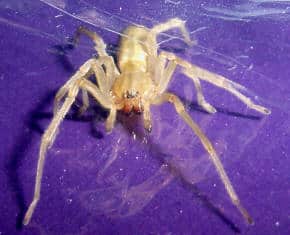
Symptoms:
- Typical symptoms of a sac spider bite include a stinging sensation followed by redness and mild swelling.
- In a few cases, the bite may blister and break, leaving a sore that can take several weeks to heal.
- Sometimes the person will feel mildly ill.
- The venom is cytotoxic.
- A slightly necrotic wound or ulcer may develop, but often heals without scarring or minimal scarring.
- This necrotic wound is much less significant than for the recluse spider.
Treatment:
- Wash the wound and apply an antibiotic ointment.
- The victim should seek medical attention if there are signs of an infection, an ulcer that does not heal, a bite accompanied by nausea, vomiting, fever or a rash.
- If infection develops, antibiotics are used. If a wound becomes deep and infected, occasionally surgery is needed.
- Anytime there is a bite or a wound that is not healing and getting worse, see your doctor.
